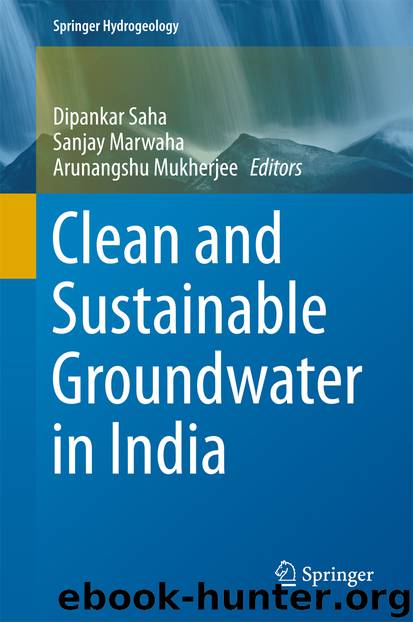Clean and Sustainable Groundwater in India by Dipankar Saha Sanjay Marwaha & Arunangshu Mukherjee

Author:Dipankar Saha, Sanjay Marwaha & Arunangshu Mukherjee
Language: eng
Format: epub
Publisher: Springer Singapore, Singapore
As Fig. 7 shows, the Sardar Sarovar Project was designed to spread surplus surface waters over north Gujarat, Kutch and Saurashtra to use surface irrigation to crowd out groundwater pumping and to accelerate groundwater recharge. Moreover, at the turn of the millennium, Government of Gujarat also invested US$150 million in 334-km-long Sujalam Sufalam spreading canal (Fig. 8) whose objective was to transfer surplus flood waters from Kadana reservoir in south-eastern Gujarat to fill up 21 rivers and streams, and several large and medium-sized reservoirs in north Gujarat, while recharging the aquifers en route. Now, the chief minister has announced a new ambitious US$1.7 billion scheme to lift to a head of 20 m a million acre feet (1.23 BCM) of Narmada water every year to fill up all dams in groundwater-depleted Saurashtra through a network of pipelines to both recharge parched aquifers and to ease pressure on groundwater (Khanna 2013). All these suggest that politicians and administrators took a more integrated view of surface-groundwater-energy co-management, while the dominant thinking in our Taskforce was limited and water-centric, focussed as it was on confining MAR to average annual non-committed surplus runoff after providing for ‘existing, under-construction and planned future’ surface structures.
Fig. 7Command area of Sardar Sarovar irrigation system
Download
This site does not store any files on its server. We only index and link to content provided by other sites. Please contact the content providers to delete copyright contents if any and email us, we'll remove relevant links or contents immediately.
International Integration of the Brazilian Economy by Elias C. Grivoyannis(75456)
The Radium Girls by Kate Moore(11625)
Turbulence by E. J. Noyes(7707)
Nudge - Improving Decisions about Health, Wealth, and Happiness by Thaler Sunstein(7248)
The Black Swan by Nassim Nicholas Taleb(6773)
Rich Dad Poor Dad by Robert T. Kiyosaki(6185)
Pioneering Portfolio Management by David F. Swensen(6083)
Man-made Catastrophes and Risk Information Concealment by Dmitry Chernov & Didier Sornette(5658)
Zero to One by Peter Thiel(5497)
Secrecy World by Jake Bernstein(4392)
Millionaire: The Philanderer, Gambler, and Duelist Who Invented Modern Finance by Janet Gleeson(4106)
The Age of Surveillance Capitalism by Shoshana Zuboff(3991)
Skin in the Game by Nassim Nicholas Taleb(3973)
The Money Culture by Michael Lewis(3850)
Bullshit Jobs by David Graeber(3837)
Skin in the Game: Hidden Asymmetries in Daily Life by Nassim Nicholas Taleb(3730)
The Dhandho Investor by Mohnish Pabrai(3564)
The Wisdom of Finance by Mihir Desai(3529)
Blockchain Basics by Daniel Drescher(3332)
